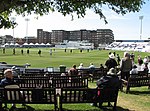75 Holland Road, Hove

75 Holland Road in Hove, part of the English coastal city of Brighton and Hove, is now in residential use as loft-style apartments called Palmeira Yard, but was originally a repository belonging to the Brighton & Hove Co-operative Supply Association, the main cooperative business organisation in the area. Elaborately designed in 1893 in the French Second Empire style by local architect Thomas Lainson of the firm Lainson & Sons, the storage building had built-in stables and was lavishly decorated with terracotta. After a period of ownership by haulage and removals company Pickfords, who used the building for furniture storage, a local architecture firm carried out the conversion into mixed-use live-work units between 2004 and 2006. English Heritage has listed the building at Grade II for its architectural and historical importance.
Excerpt from the Wikipedia article 75 Holland Road, Hove (License: CC BY-SA 3.0, Authors, Images).75 Holland Road, Hove
Holland Road,
Geographical coordinates (GPS) Address Nearby Places Show on map
Geographical coordinates (GPS)
| Latitude | Longitude |
|---|---|
| N 50.8276 ° | E -0.1613 ° |
Address
Holland Road Baptist Church
Holland Road 65-71
BN3 1JN , Brunswick
England, United Kingdom
Open on Google Maps










